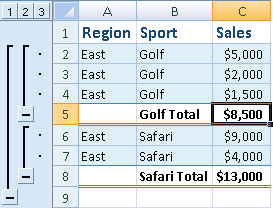

You can also use this technique with other formulas like COUNT or AVERAGE etc… An easier way over cycling through each sheet individually. The formula will sum up C3 across each of the sheets Jan to Dec. In the Subtotal dialog box, Select Name under At each change in: Select Sum under Use function: Select Unit and Amount under Add subtotal to: Unselect Replace current subtotals. Your sum formula should now look like this. The data is grouped with three Levels and the subtotals are calculated location wise as described earlier. The IF function in Excel is an inestimable ally when we need to implement conditional logic, that is when we need different results depending on a condition. Add a closing bracket to the formula and press Enter.
Hold Shift key and left click on the Dec sheet. Left click on the Jan sheet with the mouse. Type out the start of your sum formula =SUM(. There is a better way!Īdd the sum formula into the total table. =Jan!C3+Feb!C3+Mar!C3+Apr!C3+May!C3+Jun!C3+Jul!C3+Aug!C3+Sep!C3+Oct!C3+Nov!C3+Dec!C3Ĭreating this formula isn’t very efficient though, as it requires selecting the Jan sheet, then selecting the cell C3, then typing a +, then selecting the Feb sheet etc… Going through 12 sheets in all. If you wanted to create a Total sheet and have a table in it that sums up each of the tables in the Jan to Dec sheets, then you could use this formula and copy it across the whole table. And adding a summary or Grand Total line at the bottom. Adding page breaks between subtotaled sections. These options include: Designating where you want the subtotals to appear. Each sheet is the same format with the table in the same position within each sheet. That brings up the Subtotal window with options and choices for customizing your subtotals. In this example, we have a table of sales figures each in a separate tab named Jan through Dec. The image below shows the result (the workbook is opened in Microsoft® Excel®).If you’ve ever had to sum up items across many different sheets, then you know it can be a real pain when there are a lot of sheets. Worksheet.Subtotal(dataRange, 1, subtotalColumnsList, 9, "Total") ' Insert subtotals by each change in the column "B" and calculate the SUM fuction for the related rows in the column "D". ' Specify that subtotals should be calculated for the column "D".ĭim subtotalColumnsList As New List(Of Integer)() = worksheetĭim dataRange As CellRange = worksheet("B3:E23") Worksheet.Subtotal(dataRange, 1, subtotalColumnsList, 9, "Total") ĭim worksheet As Worksheet = workbook.Worksheets("Regional Sales") Insert subtotals by each change in the column "B" and calculate the SUM fuction for the related rows in the column "D". For example, if you wanted to count the number of cells in ranges A2:A9 and B2:B9, use the formula SUBTOTAL(102,A2:A9,B2:B9), making sure to close the formula with a closing parentheses. Specify that subtotals should be calculated for the column "D". If you want to create a subtotal using multiple cell ranges, you can add these (one after another) after the functionnum method is specified. = worksheet ĬellRange dataRange = worksheet Worksheet worksheet = workbook.Worksheets 
You should be able to sort the Row Labels in a different order by clicking the 'More Sort Options' from the filter drop down, in order to get your P&L in the right order. Microsoft Excel defines Subtotal Function as It returns a subtotal in a list or database. Otherwise you could create a new calculated column for Gross Profit for instance thats equal to Sales+ COGS.
#How to add multiple subtotals in excel code
The SUM function with code 9 is used to calculate subtotals. Subtotal Function in Excel is a wonderful formula that can be used to perform some specific arithmetic and logical operation on a defined range of cells. In this example, a subtotal row will be inserted each time a value in column “B” (with Column.Index equal to 1) changes. Organizing the large data by combining the subcategory data is the process and it’s called Grouping of Rows in excel. In this example, the SUBTOTAL function will be calculated only for column “D” (with Column.Index equal to 3).Ĭall the Worksheet.Subtotal method and pass the following parameters: the specified data range to be subtotaled, the index of the column by which you wish to group your data, the specified list of columns to which the subtotals should be added, the code of the function to be used in calculating subtotals and the text to be displayed in the summary rows.
Create a list of column indexes that define columns for which the subtotals should be calculated. Specify the CellRange object, which contains data you wish to subtotal. 
Before subtotaling, make sure that the range you wish to subtotal has column headings in the first row and the data in this range is sorted by a column at each change in which a subtotal row will be inserted.







 0 kommentar(er)
0 kommentar(er)
